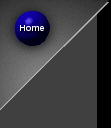 |
The Great Floyd Block Debate
Since the 80's, many pro guitarists were very interested in increased sustain and resonance from their Floyd Rose systems. Floyds, naturally, compared to string through or stop tail piece type guitars have less overall sustain due to increased parts, more movement, and less connection to the body in some cases. Many players in the 80's used larger trem blocks (blocks the springs hook into) for increased sustain. In fact, the early Floyd systems introduced by Floyd on Kramer Pacer models in 1982-83 even came stock with large brass blocks. You can even see the larger brass block on Eddie Van Halen's 5150 guitar. Warren Dimartini used the same sort of block as well in his Floyd equipped guitars.
Over the last two years, many companies have released after market blocks, in addition to offering different metals other than just brass. It should be noted that, with every block, there is always a tonal difference. Many of these tonal differences and sustain/resonance differences are in the ear of the beholder. Its very difficult to get any sort of constant when testing these blocks due to a consistent string pluck, or same string types, the same guitar, etc. Our intent in this review are to report our findings, after trying the large brass block, large titanium block, and the just released smaller, Tungsten block. Let it be noted, as there are many misconceptions about stock Original Floyd Rose blocks out there - the stock Floyd blocks are BRASS, albeit, with chrome coating. They are not other metal types as others have stated in different articles. They are just smaller blocks overall compared to the larger brass blocks offered aftermarket.
It is important to note, with all three offerings, all offer an upgrade in resonance and sustain. The Titanium block is the only stand out in that, it tends to be more bright/more treble than the brass offerings. The brass and tungsten just adds that extra "umph" in terms of low end, whereas the titanium is more bright. There are players that prefer a crisper tone and may prefer what titanium has to offer over brass. All blocks offered from both vendors are available in different lengths depending upon the depth of the cavity or how a guitar is setup - recessed or fixed. Make sure and check your existing block's length to ensure you order the right block for your Floyd/guitar. |
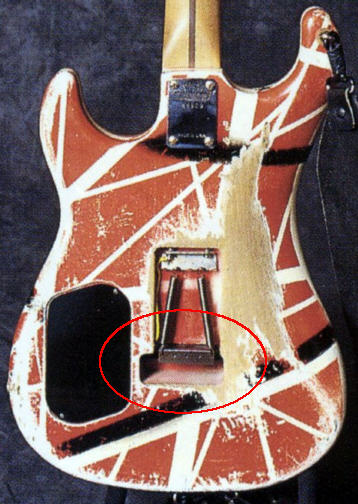 |

Large Brass Block
Adam Reiver with floydupgrades.com was one of the first to offer an aftermarket large brass block. Many people have commented on the change in overall tone and character from these. In our testing, I can also report the large brass block had a substantial change in tone from the stock Floyd block. Of course, resonance and sustain were improved, and additionally, harmonics were even noted as being increased. We had very simi liar results to that of the Tungsten block. I'd stay the large brass is version 1.0 of amazing, improved Floyd performance, while Tungsten is the 2.0 version in a smaller package. Both give the same overall tonal effect. The purists more than likely will go with a large block, due to an established artist base that are already using these.
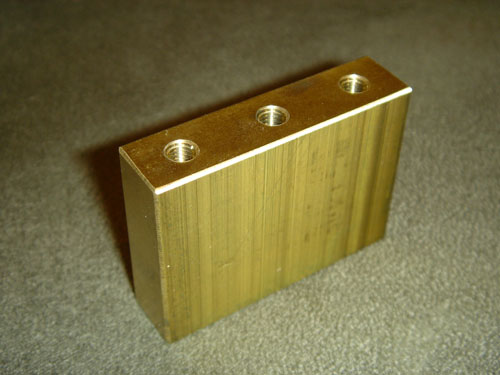 |
The downside to the large blocks is the possible interference you may encounter in your trem cavity. I installed the brass block in a Charvel Socal model. The block hit the inside of the cavity, thereby making the stock floating Floyd setup "blocked" since it stopped where it connected to the inside of the cavity. In my case, I actually liked this side effect, in that, it gave a guitar the ability to be fixed against the body thereby making contact of Floyd to body better. However, many will say this took away the ability to pull notes sharp. Additionally, this may not be the case with all trem cavities, this side effect may only be a problem with certain guitar models.
Another plus of the floydupgrades.com offerings are "L" brass blocks that offer more mass than just a square block.
They also offer a block for Gotoh trems, which is a very welcomed product for Ernie Ball guitar users. I know personally I'd like to purchase a couple of these for my Ernie Ball guitars and OLP equipped with a Gotoh. Additionally, the store offers titanium saddles for Floyds, in addition to other nice add ons for licensed Floyd Rose systems. One other item of note are the noiseless springs, something that MANY will consider to be an improvement on original Floyd systems in addition to Ibanez licensed Floyd versions.
Prorockgear.com also sells the large brass block as well.
Tungsten
Tungsten is, in nature, a more dense metal than brass. It is also heavier. Recently, prorockgear.com released a stock sized tungsten block to compete with the larger brass blocks.
Here is what they have to say about their particular offering:
"Our exclusive tungsten sustain blocks for Floyd Rose tremolo bridges offer the highest density available in block that conforms to the original size specifications of your Floyd Rose bridge. When it comes to sustain, the single most important property of a metal is density followed by hardness. Tungsten is over 4 times denser than titanium and more than twice as dense as brass. To equal the mass of our tungsten sustain block, you would need a titanium block 4 times the size and a brass block double the dimensions of our tungsten block. Most standard tremolo spring cavities simply aren't large enough to accommodate bulky sustain blocks sold by other companies. Ours is a direct replacement for the stock sustain block adding up to a half pound of mass to your bridge.
Why are density and mass important to sound and sustain? A fixed guitar bridge efficiently transmits string vibration from the bridge to the body through a large contact area but tremolo bridges are limited by a few very small attachment points. A great deal of resonance is lost to the bridge through the tremolo springs because the springs absorb and dissipate vibration very well. This is one of the reasons expensive studio microphones are suspend by springs to isolate external vibrations. A high density sustain block means greater inertia which means less string vibration transmitted to the springs and more in the bridge where it belongs.
Soft metals absorb sound and cancel sustain. Tungsten is much harder than steel and titanium and over twice as hard as brass. No other metal offers the perfect combination of mass and hardness.
With our tungsten sustain block, every note will be brighter with a significant increase in clarity and sustain."
The Tungsten block I received was installed in a guitar that was already very resonant, and tonally one of the best guitars I own. Without doing any sound wave comparisons or detailed testing, I can report that overall, the tungsten block performed as good as the large brass block installed in the same guitar. Of course the size of the tungsten block is a plus, and comparatively to the size of the titanium/brass large blocks, there is no interference with the trem's movement. The guitar really came to life, and I had already thought this guitar was very resonant to begin with. When gigged, you could physically feel the power of the resonance at a loud volume, to use a description from others, it really hit you in the chest. There is most definitely a difference when installing this aftermarket block offered by prorockgear.com.
Prorockgear also offers some really competitive pricing on Floyd Rose tremolos, including the recently released Floyd Rose Special which is made in Asia, to exact Original Floyd Rose specifications. The also offer Floyd parts and other items you may find useful, so go check them out if you get a chance.
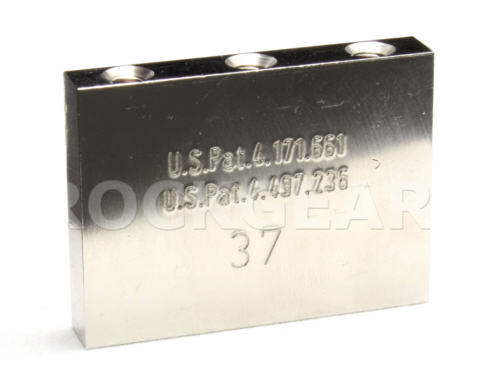 |
Titanium
Titanium is yet another offering from the floydroseupgrades.com store. As explained earlier, the tone is improved, but overall is a tad more brittle and bright compared to brass and tungsten. In our testing, we installed the titanium block a Charvel Socal, which already had a significantly bright tone due to a thick polyester finish. The result though is not bad, actually, with the right amp settings, it actually increased the harmonics significantly over the brass, we just had to re-eq the test amp in order to adjust for the bright sound. At loud volumes, the increased treble actually lent more to a early VH type tone, with those screaming harmonics and enhanced treble.
I'm really curious as to how this bridge would perform in a darker tone wood such as mahogany. The overall effect could be an incredible combination, in that, if the right pickup were chosen as well with dark characteristics, the brightness would balance out the tone.
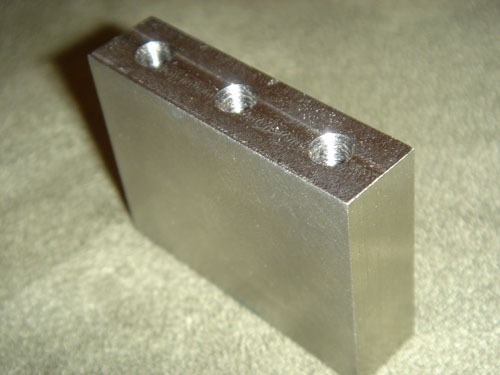 |
Overall, there are quite a few resources when choosing to upgrade your Floyd. You can even purchase many of these blocks through other vendors who offer the same sort of products. Both vendors mentioned here are established - they've both gone through the rigors of really studying and understanding how Floyd Rose systems work. My overall "winner" here would be a tie between the large brass block and the tungsten block - both have benefits. The side benefit of the larger block is something to consider if you want to make your Floyd stationary to down movement only, something I generally prefer. Others will not like this side effect.
I'd like to hear other reviews of the Tungsten blocks. My overall impression was the same between large brass and small tungsten, but as with any tonal upgrade or change to your guitar, the sound is in the ear of the beholder. Try them out for yourself, all three of these options are definitely better than the stock option.
Special thanks to Steve Z and Adam Reiver for their assistance in this review.

|



